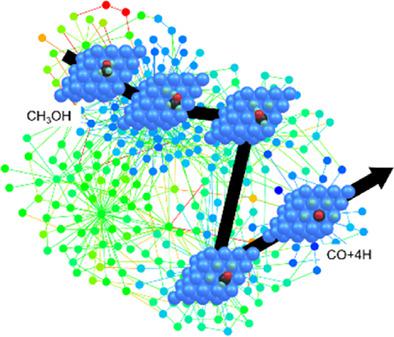当前位置:
X-MOL 学术
›
J. Comput. Chem.
›
论文详情
Our official English website, www.x-mol.net, welcomes your
feedback! (Note: you will need to create a separate account there.)
A reaction route network for methanol decomposition on a Pt(111) surface
Journal of Computational Chemistry ( IF 3.4 ) Pub Date : 2021-08-25 , DOI: 10.1002/jcc.26746 Kanami Sugiyama 1 , Kenichiro Saita 2 , Satoshi Maeda 2, 3, 4, 5
Journal of Computational Chemistry ( IF 3.4 ) Pub Date : 2021-08-25 , DOI: 10.1002/jcc.26746 Kanami Sugiyama 1 , Kenichiro Saita 2 , Satoshi Maeda 2, 3, 4, 5
Affiliation

|
A reaction route network for the decomposition reaction of methanol on a Pt(111) surface was constructed by using the artificial force-induced reaction (AFIR) method, which can search for reaction paths automatically and systematically. Then, the network was kinetically analyzed by applying the rate constant matrix contraction (RCMC) method. Specifically, the time hierarchy of the network, the time evolution of the population initially given to CH3OH to the other species on the network, and the most favorable route from CH3OH to major and minor products were investigated by the RCMC method. Consistently to previous studies, the major product on the network was CO+4H, and the most favorable route proceeded through the following steps: CH3OH → CH2OH+H → HCOH+2H → HCO+3H → CO+4H. Furthermore, paths to byproducts found on the network and their kinetic importance were discussed. The present procedure combining AFIR and RCMC was thus successful in explaining the title reaction without using any information on its product or the reaction mechanism.
中文翻译:

Pt(111) 表面甲醇分解的反应路线网络
利用人工力诱导反应(AFIR)方法构建了甲醇在Pt(111)表面分解反应的反应路径网络,可以自动、系统地搜索反应路径。然后,通过应用速率常数矩阵收缩(RCMC)方法对网络进行动力学分析。具体而言,通过RCMC方法研究了网络的时间层次、最初给予CH 3 OH的种群到网络上其他物种的时间演化以及从CH 3 OH到主要和次要产物的最有利路线。与之前的研究一致,网络上的主要产物是 CO+4H,最有利的路线通过以下步骤进行:CH 3 OH → CH 2OH+H → HCOH+2H → HCO+3H → CO+4H。此外,还讨论了在网络上发现的副产品的路径及其动力学重要性。因此,结合 AFIR 和 RCMC 的本程序成功地解释了标题反应,而无需使用有关其产物或反应机理的任何信息。
更新日期:2021-10-09
中文翻译:

Pt(111) 表面甲醇分解的反应路线网络
利用人工力诱导反应(AFIR)方法构建了甲醇在Pt(111)表面分解反应的反应路径网络,可以自动、系统地搜索反应路径。然后,通过应用速率常数矩阵收缩(RCMC)方法对网络进行动力学分析。具体而言,通过RCMC方法研究了网络的时间层次、最初给予CH 3 OH的种群到网络上其他物种的时间演化以及从CH 3 OH到主要和次要产物的最有利路线。与之前的研究一致,网络上的主要产物是 CO+4H,最有利的路线通过以下步骤进行:CH 3 OH → CH 2OH+H → HCOH+2H → HCO+3H → CO+4H。此外,还讨论了在网络上发现的副产品的路径及其动力学重要性。因此,结合 AFIR 和 RCMC 的本程序成功地解释了标题反应,而无需使用有关其产物或反应机理的任何信息。











































 京公网安备 11010802027423号
京公网安备 11010802027423号